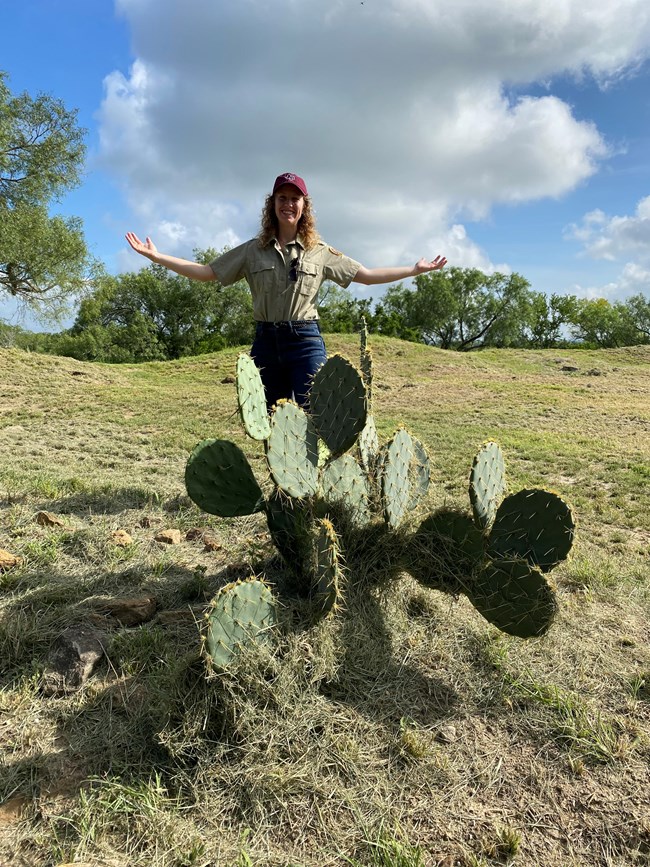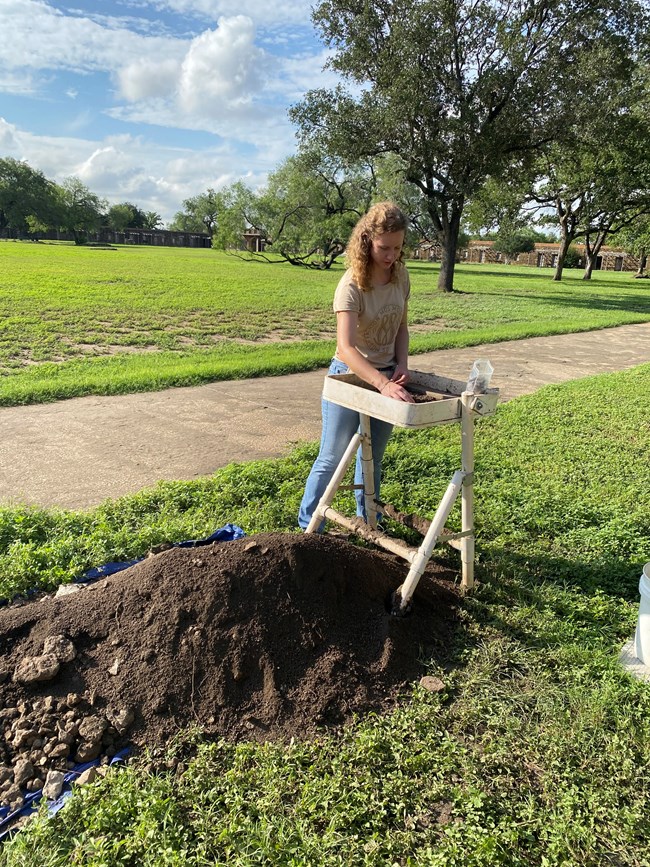Last updated: August 27, 2024
Article
Intern Spotlight: World Heritage USA Intern Christl Høj Hansen

NPS Photo
Meet Christl! She is the 2024 World Heritage USA Intern at San Antonio Missions National Historical Park. Christl works alongside National Park Service staff to learn important job skills and address cultural resources projects such as collections management, integrated pest management, museum housekeeping, and research during her time at San Antonio Missions National Historical Park.
The San Antonio Missions are a UNESCO World Heritage Site. The site encompasses a group of five frontier mission complexes situated along a stretch of the San Antonio River basin in southern Texas, as well as a ranch located 37 kilometres to the south. It includes architectural and archaeological structures, farmlands, residencies, churches and granaries, as well as water distribution systems. The complexes were built by Franciscan missionaries in the 18th century and illustrate the Spanish Crown’s efforts to colonize, evangelize and defend the northern frontier of New Spain. The San Antonio Missions are also an example of the interweaving of Spanish and Coahuiltecan cultures, illustrated by a variety of features, including the decorative elements of churches, which combine Catholic symbols with indigenous designs inspired by nature. Read more about the site, its history, and integrity here.
Since 1984, the United States Committee of the International Council on Monuments and Sites (ICOMOS-USA) International Exchange Program (IEP) has worked with partners around the world to provide hands-on training opportunities for emerging cultural heritage professionals. The IEP sends participants from the United States to internship placements abroad and welcomes international participants to placements in the United States in order to expose the next generation of heritage professionals to global best practices of historic preservation and heritage conservation. This one of a kind cultural heritage internship emphasizes the cross-cultural exchange of ideas and practices, enabling hosts and interns to learn from one another and increase their impact in the heritage field. To date, more than 700 interns from over 100 countries have participated in the program. The program at the park is made possible with funding from Mission Heritage Partners.

NPS Photo
Tell us a little bit about yourself!
I've always loved travelling and going to new places. I find joy in experiencing and learning about different cultures and exploring natural phenomena. I am particularly fond of waterfalls.
Learning about the world around me has led me to pursue a career in heritage which combines my love for both nature and culture. Throughout my education, I have learned to appreciate how cultural and natural resources such as archaeology and climate reflect the lives and societies of people in the past.
I recently graduated with an MA in Sustainable Heritage Management from Aarhus University in Denmark. I did my bachelor’s degree in archaeology at The University of Edinburgh in Scotland. My first time working in a museum was during my master’s, where I did a semester long internship with the Workers Museum in Copenhagen. I worked with public programs and activities, as well as conducting research on world heritage management for a nomination project. This experience developed into my thesis project where I investigated the process to nominate workers’ assembly halls to the World Heritage List. I argued the World Heritage List should represent the everyday persons contributions, such as the workers’ assembly halls.
I submitted my thesis three days before travelling to the U.S. for the first time to participate in an incredible internship experience at San Antonio Missions National Historical Park. Throughout my time in San Antonio, I have learned a lot about the complex history of Texas. I also took the opportunity to immerse myself in American and Texan cultures, through food, cultural events, and the wonderful people I have met here.

NPS Photo
How did you get involved with the National Park Service?
I got involved with the National Park Service (NPS) through the international exchange program hosted by World Heritage USA (ICOMOS-USA). The internship began with an orientation in Washington D.C. for all twelve interns. We visited museums, Capitol Hill, the Library of Congress, and official heritage institutions, such as the Department of the Interior and U.S. Commission of Fine Arts, where we met with professionals in the field of cultural heritage. This provided a thorough introduction of the complex nature of how the cultural heritage sector works in the U.S., which has a multitude of stakeholders working at different levels, federal, state, regional and local.
I had little knowledge of the National Park Service before starting my internship, but I have been on a steep learning curve since arriving. I am finding myself wishing that I was able to continue working with the NPS. The combination of desk work with field work and outings have been incredible. It has strengthened my understanding of the importance of the San Antonio missions and the significance of their settings in the landscape and its descendant community. San Antonio Missions National Historical Park and San Antonio Missions World Heritage Site is working with the diverse indigenous and other traditionally associated communities toward an inclusive, respectful recognition of the complex human history of this special place. A good example is the water and land acknowledgement which works towards a more just, equitable, relevant, and inclusive approach to site understanding and management.
Additionally, I enjoyed gaining hands-on, applied World Heritage Site management experience through the lens of the National Park Service. Moreover, my eyes have been opened to working in a federal agency with 431 park units, which provide opportunities for job mobility and an amazing network of passionate people working to protect and promote cultural and natural resources in the U.S.

NPS Photo
Tell us a little bit about what you do in your position?
My internship is focused on museum collections care and management. I am working in the Integrated Resources Division, where I work closely with the Museum Curator helping to preserve the park’s cultural resources. The park’s museum collection contains more than one million artifacts and historical documents that encompass the largest collection of Spanish Colonial mission artifacts in the United States. These objects and documents provide a tangible link to the missions and people before, during, an after the mission period. The collection includes historical and archeological objects such as coins, projectile points, ceramics, jewelry, and architectural elements as well as historic photographs, maps, and other documents.
My main project is to develop the park’s first Museum Housekeeping Plan, which is an integral part of a preventive conservation program. Additionally, I am collaborating with the Park Biologist to develop a comprehensive Museum Integrated Pest Management Plan (IPM). We consulted with curators from the Witte Museum and the Center for Archaeological Research at UTSA to gain additional professional insight. The Museum Housekeeping Plan is a core museum baseline document within the National Park Service and is required for all spaces housing museum collections. This involves a lot of research on how to store and handle artifacts based on material type, as well as best practice cleaning techniques and ideal frequency to ensure artifacts are protected from agents of deterioration and safeguarded for the future. I am also learning a lot about the strategic prevention and monitoring of museum pests.
I have also been able to go on site visits to Missions Concepción, San José, San Juan and Espada, as well as the museum collection storage facilities. It was interesting to view museum sites with a fresh perspective to understand how different sites holding museum collections address housekeeping tasks and IPM compared to non-museum buildings. Working on these projects have also led to networking opportunities through site visits to other museums and collection repositories and constructive discussions on housekeeping and pest management in museum and storage facilities throughout Texas.

NPS Photo
In addition to my primary project, I worked with archeologists excavating test pits at Mission San Jose to determine if the reconstructed walls were built directly on top of the original ones. I helped by screening artifacts as the archeologist dug layer by layer. I got to see firsthand the type of artifacts found in the compound and how they are used to interpret the social lives at the missions.
I was also able to spend a day in the sun and dust doing preservation work on the east wall at San Juan with the masons. I learned to mix mortar and repoint a section of the wall in a larger effort to stabilize the wall surrounding the compound at Mission San Juan. I enjoyed hands on preservation work!

NPS Photo
I have also had the opportunity to delve into areas of heritage preservation practices beyond my immediate projects. I helped test remote sensing techniques ahead of a climate change vulnerability assessment for Mission Concepcion, aiming to investigate the extent of the tufa stone in the subsurface. This aligned well with my personal research interest on climate change affects on cultural heritage. The potential affects of climate change on cultural resources were an integral part of my masters' degree, so it was an interesting experience to contribute to this project in a practical way and learn a new aspect of climate change adaptation in an area where extreme heat and floods are potential future scenarios.

NPS Photo.
How do you see museums changing in the coming years?
Museums must stay relevant in our changing society, as trusted institutions they are relied upon to also be frontrunners of change. During my internship, I explored preventive conservation and its vital role in extending the life of objects. With growing awareness of climate change and sustainability, museums are adopting new management and collection care methods. Preventive conservation is crucial for preserving museum items; it emphasizes that "clean" means more than just being squeaky clean. It involves removing harmful agents like pests and dust and maintaining appropriate temperature and humidity levels. Understanding when and how to clean and handle individual objects is essential for providing consistent, high-quality care for museum collections.

NPS Photo.
What have you learned that you will take with you in your career?
My internship at San Antonio Missions National Historical Park has been an amazing learning experience, which has taught me many valuable skills in museum management and collection care.
The skills I have learned in handling and cleaning artifacts while following a preventive conservation approach provide a strong foundation of practical knowledge that I will take with me and continue to build on further on. I am especially thankful for learning about the many factors and considerations involved in collection storage. It's not just about protecting each item on a shelf but creating and maintaining an overall safe environment from the specific shelf unit to the environment of the entire building and understanding how external climate conditions and pests can affect the collection. This has broadened my appreciation of the possibilities and opportunities of working with museum collections.
Before this internship my understanding of networking was based on connecting at conferences and events, but in reality, networking happens with both external and internal colleagues across various disciplines. By doing so, one can create a network of knowledge sharing in their community and across heritage institutions.
Overall, the internship has sparked a newfound enthusiasm for the many possibilities in museum work to preserve our cultural heritage, and I am excited to bring these experiences with me and to further develop my skills and expertise in my future career.
